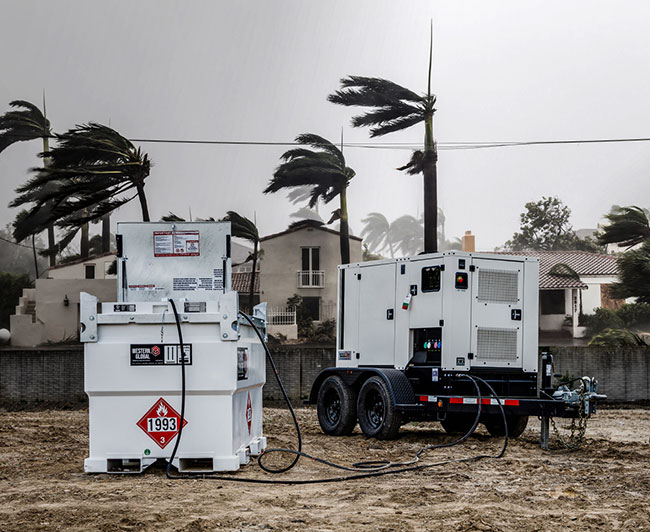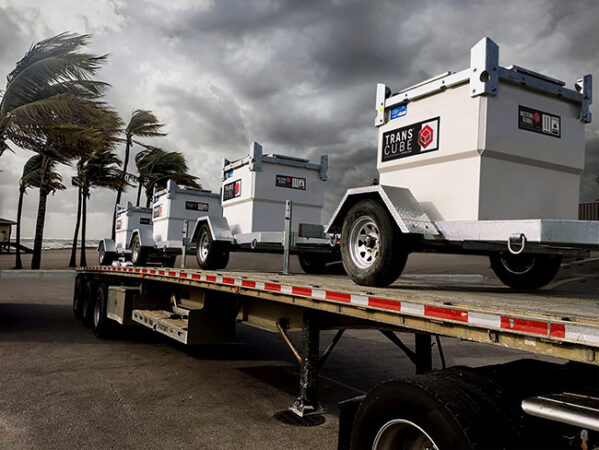
Ready for the unexpected
By John Cleary
Features Rental Equipment Tech tips disasterKeep fuel storage solutions top of mind for disaster preparedness.
 Fuel supplies taken into areas experiencing extreme weather may need pumps, meters and other sensitive equipment protected from the elements.
Fuel supplies taken into areas experiencing extreme weather may need pumps, meters and other sensitive equipment protected from the elements. Natural disasters are unpredictable and involve many variables. Operations must anticipate and plan for a variety of complications in the event that a disaster strikes, but the loss of power frequently proves to be one of the most common challenges in these situations.
Factors like high winds, floodwater, lightning and hail all risk causing damage to utility towers and power plants, leading to power outages that can last days, weeks or even longer.
Access to generators is a key component in emergency response plans. Generators provide power for critical services, help produce lighting for disaster relief work and allow for business continuity. When selecting a generator, the focus often tends to revolve around power requirements, but in emergency situations, another key factor should not be overlooked: generator runtime. Most generators come with an internal tank that holds enough fuel to power the generator for approximately 24 hours. This means that without any additional fuel storage, the response plan must include resources to refuel the generator every day.
One fuel supply option is wet hosing, with a fuel truck visiting the site daily to add to the generator’s tank, but this method has drawbacks. Drivers are in high demand due to frequent turnover and increased requirements to attain the proper licensing and endorsements. This alone can lead to the risk of missed deliveries. Add to that a higher demand for fuel and a surge in scheduling in times of emergency, and daily deliveries can be hard to come by. Additionally, wet hosing adds daily traffic to busy work areas, which may be even more crowded or inaccessible following a natural disaster.
To address these challenges, some operations turn to a traditional round tank to store additional fuel in the work area. Round tanks offer on-site fuel storage so operations can buy in bulk and have more fuel available, but these tanks bring challenges of their own. Round tanks take time to set up when they arrive at the site and require secondary containment pans that can be a hassle. Additionally, they are used simply to refuel generators — one at a time — which means a plan needs to be in place to add fuel to the generator daily to be sure power is not interrupted.
A new solution
Every minute counts in emergency situations. The time spent checking and refilling tanks can add up to hours of wasted time. This is why more operations are turning to modern, cube-shaped on-site fuel tanks to extend the run time of their generators. This option offers a direct connection to the generator as an auxiliary fuel supply, extending the generator’s run time from 24 hours up to seven days and reducing fuel delivery requirements from once per day to once per week. Some of these tanks can even be used to fuel up to three pieces of equipment at the same time, meaning they can extend the run time of three generators simultaneously, or be used to refuel other equipment at the work site while still providing a continuous source of fuel for the generator.
Beyond extending generator run time, cube-shaped fuel tanks offer the benefits of double-walled containment. Traditional round tanks require a secondary containment pan to prevent contamination. This takes time to set up at work sites and must be emptied and cleaned when it fills with rainwater and debris. With their innovative design, cube-shaped fuel tanks arrive at the work site with this critical environmental protection component already in place. They incorporate an outer wall that contains any spills and prevents the containment system from filling with storm water. These tanks provide peace of mind in any situation, especially those that may already be dealing with a widespread environmental impact.
This double-walled design also protects the tank itself from the elements — a factor that is even more important during ongoing weather events when conditions remain unpredictable. Some models also feature an enclosed, weatherproof cabinet to secure the inner tank and the supporting components inside the outer wall of the tank. This extends the life of pumps, meters and other equipment and reduces the risk of damage or contamination as the tank is battered by the wind and rain.
Additionally, some manufacturers offer cube-shaped fuel tanks with the hoses and pumps pre-installed for a true plug-and-play solution. With built-in secondary containment and all the components already set up, these tanks arrive at the work site ready to go — a simple solution that doesn’t require extra training and saves valuable time during disaster response.
Moving with the conditions
Natural disasters are unpredictable. While operations can plan for power needs in the event of an outage, it can be nearly impossible to project which roadways will be inaccessible or where power generation will be needed as cleanup progresses. Transportable fuel tanks shine in these situations.
Some cube-shaped fuel tanks have the required approvals and accreditations by organizations like the U.S. Department of Transportation and Transport Canada to move the tanks while filled with fuel. They can be moved around a worksite with a forklift or crane and over the highway on a truck or trailer. This provides more options to provide fuel in hard-to-access areas and the ability to have the tanks delivered to the jobsite pre-filled with fuel — allowing for rapid deployment in an emergency. It also saves valuable time by eliminating the need to drain the tank when it needs to be relocated as the situation unfolds.
Consider the example of a U.S. town that, when drowning in floodwater, partnered with an emergency fuel provider and a transportable fuel tank manufacturer to provide clean, environmentally secure fuel to homeowners and healthcare facilities. With a convenient cube shape and applicable approvals for full-fuel transport, two transportable fuel tanks were stacked onto the bed of a repurposed military vehicle. This custom solution simplified fuel delivery through the swamped streets. Additionally, the double-walled containment of the fuel tanks created a secure cabinet to retain spills and prevent floodwater from seeping in.
The long haul
While emergency response planning often focuses on the immediate aftermath of a disaster, operations must also consider the possibility of extended power outages during long-term recovery efforts. While disaster can strike in an instant, the rebuilding process doesn’t move as quickly.
When a tornado tore through a water bottling facility in Texas, transportable fuel tanks were the key to resuming production while the company rebuilt. Working with a temporary power provider, the company used 10 power units to start up production at the damaged facility. The generators used a constant supply of fuel, fed by 11 transportable fuel tanks, to run around the clock for several months. The cube-shaped tanks were stacked for ease of transport and arrived filled with fuel. This offered a cost-effective solution with instant fuel on-site, which allowed the bottling plant to return to business and continue operations through the extended loss of power.
With the ability to be stacked, cube-shaped tanks provide more options than round tanks when it comes to limited on-site space. Some models can be stacked up to three high when empty or two high when filled with fuel. This provides a space-saving solution when storing empty tanks to have on hand in the event of an emergency. It also offers more efficient transport and reduces the footprint at the work site when multiple tanks are required. This feature is critical when working in areas with limited space as clean-up takes place and for long-term disaster recovery when the surrounding area is needed for other equipment or traffic.

The portability of square fuel tanks is key when delivering to disaster relief areas. Stackable and moveable with a variety of lift solutions, square fuel tanks can be used where space and access is at a premium.
Desperate times
As the saying goes, “Desperate times call for desperate measures.” Emergencies can bring out the best and the worst in people. While many rally to help those in need, there are often those who look to take advantage of the situation. The cost of fuel has been steadily on the rise, and natural disasters can create even more demand for this valuable commodity.
One of the concerns with traditional on-site fuel tanks is the increased risk of theft from ports and pumps located on the outside of the tank. Thankfully, some manufacturers have designed fuel tanks with features to be a step ahead of the game with anti-theft technology. This reduces the financial risk that comes with loss from theft and ensures the fuel is available to keep generators and other work site equipment running.
Operations should look for cube-shaped tanks that house the pump and assets in a secure cabinet with card-locked dispense controls so only authorized individuals can access the fuel.
Some tanks are even designed with remote tank monitoring systems that can aid in theft prevention and keep tabs on the fuel tank’s supply. This allows the emergency response team to check exactly how much fuel is on hand, no matter where they are located throughout the day. These systems can also send personalized alerts and customizable reports through email or text, freeing up personnel to focus on their many other responsibilities rather than making frequent visits to the tank to make sure the fuel level isn’t running low. Taking technology even further, some transportable tanks incorporate built-in GPS systems that help work site managers monitor the tank’s exact location and help equipment operators find the nearest tank if they need to refuel.
Generating rapid response
Through the planning process, operations should determine a base number of fuel tanks to have on hand to activate when needed. However, they must also identify how they will access additional tanks if the disaster calls for a larger response. Rental centres shouldn’t overlook building a relationship with a reliable partner who can respond quickly in emergency situations. During Hurricane Ida in 2021, a transportable fuel tank manufacturer received a call on a Sunday morning when help was needed. A team of people was brought in to fulfill the request and 40 tanks were ready to ship that evening.
Generators and fuel tanks go hand-in-hand, and these items will be in high demand when disaster strikes. But even with all the uncontrollable variables in these situations, proper planning for equipment needs in the event of an emergency can help operations weather the storm.
John Cleary is Western Global Americas’ vice-president of sales.
Print this page
Leave a Reply